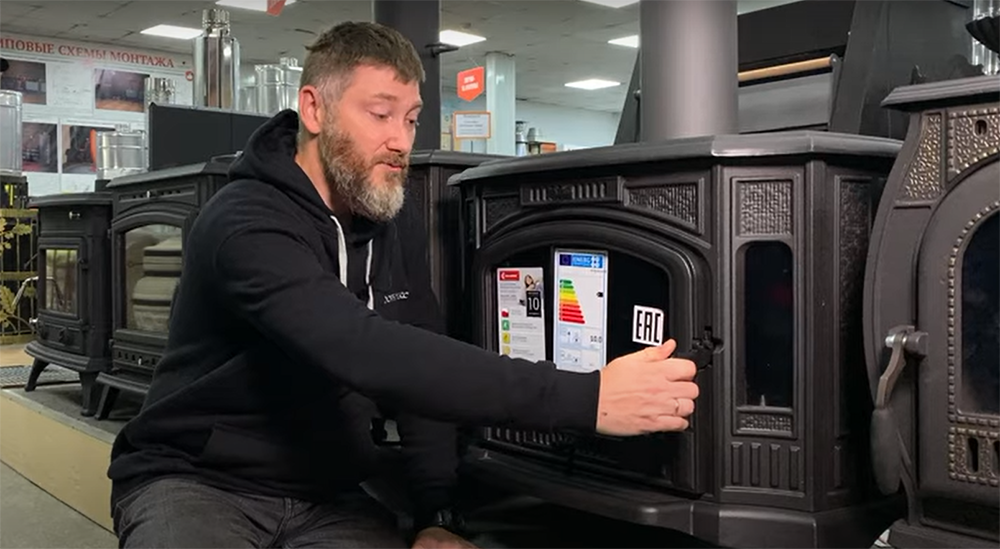Never underestimate the power of a fireplace. If you’ve ever felt warm when standing in front of one, then chances are good that your body has been tricked into believing it’s hot! So what gives? Why do we get fever-warming from simply viewing flames – even though they’re just dancing around without any real heat behind them at all?! To answer this burning question check out this blog post where we are going to explore the science behind this phenomenon!
What is the Purpose of a Fireplace?
A fireplace is basically a hole in the wall that you build a fire in. The purpose of a fireplace is to provide warmth and heat to a room. Fireplaces come in all shapes and sizes, but they all serve the same purpose.

The reason you get warm standing in front of a fireplace is because of the radiation emitted from the fire. Radiation is simply energy that travels through the air and is absorbed by your body. The heat from the fire warms up your body and makes you feel comfortable. It’s important to note that not all fireplaces are created equal. Some fireplaces are more efficient than others and will radiate more heat into the room. If you’re looking for a way to stay warm this winter, make sure you choose a fireplace that is right for you. [1]
Types of Fireplaces
There are many types of fireplaces, but the one that usually comes to mind is the classic wood-burning fireplace. These fireplaces have a few key parts: the grate, where the wood is placed; the hearth, which surrounds the grate; and the chimney, which vents smoke and excess heat up and out of the home.
So if you’re looking to use your fireplace as a primary source of heat, you might want to consider a different type of fireplace. Gas fireplaces, for example, are much more efficient than wood-burning fireplaces. For example, gas fireplaces are significantly more energy-efficient than wood-burning fireplaces.
Of course, nothing beats the ambiance of a real wood fire. So if you’re looking to add a little coziness to your home this winter, a wood-burning fireplace is still a great option – just don’t expect it to do much in the way of heating your home! [2]
Why Do You Experience Warmth When Facing the Fireplace?
Radiation
Energy is transferred through space by electromagnetic waves, which are known as radiation. Heat is transferred through a fluid (liquid or gas) as the fluid moves via convection.

The fireplace emits infrared radiation, a type of electromagnetic radiation with a longer wavelength than visible light. This radiation is absorbed by your skin, which then heats up and warms your body. The air in front of the fire is also heated by convection currents created by the rising hot air. As this warmer air rises, it pushes the cooler air around it out of the way. That’s why you might feel a draft when you’re standing in front of a fireplace – all the cool air from around you is being pushed away! [3]
Convection
It is the main reason you feel warmth standing in front of a fireplace. Convection is heat transfer by the movement of a fluid such as air or water. The hot air from the fireplace rises and circulates around the room, warming anything it comes into contact with. The warmer air continues to rise, creating a convection current that pulls cooler air into the fireplace to be heated. This circulation of warm and cool air is what makes you feel warm standing in front of a fireplace. Moreover, the heat from the fireplace also warms the surrounding walls and furniture, which then radiates that heat back into the room, further warming the air. All these factors work together to create a warm and comfortable environment for you to enjoy.
Conduction
It is the process of heat transfer through solid objects. The fireplace is made of brick, stone, or metal, all of which are excellent conductors of heat. The heat from the fire passes into these materials and then into your body. This is why it feels warm when you are sitting before the fireplace. Conduction is the primary way that heat is transferred from the fireplace to your body.
What Is The Most Effective Fireplace For Making You Feel Warm?

The most effective fireplace for making you feel warm is one that has a large opening. The larger the opening, the more heat you will feel. If you have a small fireplace, you may not feel as much heat because the hot air will escape out the top of the fireplace before it has a chance to circulate around your body. When choosing a fireplace, make sure to choose one that will fit in the space you have available and that has a large opening. You may also want to consider adding an insert to your fireplace to help increase the amount of heat it produces. An insert helps to create a barrier between the fire and the room, allowing less heat to escape up the chimney. By keeping more heat in the room, you will be able to enjoy the warmth of your fireplace for a longer period of time.
If you are looking for a way to improve the efficiency of your fireplace, you may want to consider investing in a gas insert. A gas insert is placed inside the firebox of your fireplace and uses natural gas or propane to produce heat. Gas inserts are very efficient and can provide a great amount of heat without using a lot of fuel. They are also easy to operate and can be turned on and off with the flip of a switch. If you are interested in adding a gas insert to your fireplace, be sure to talk to a professional about installation and safety procedures.
Is a Fireplace Really Worth It?
The science behind why you get hot when you stand in front of a fireplace is surprisingly easy. When you stand in front of a fire, the heat from the fire warms your body. This process is called convection. Convection is when heat moves from one place to another by circulating fluids or gasses. In this case, the fluid is air and the gas is your body. The heat from the fire causes the air around you to move and as it does, it transfers that heat to your body.

Forced convection is when the fluid (in this case, air) is forced to move by something other than natural convection. In a room with a heater, the air is forced to circulate by the fan in the heater. This causes the air to move faster and makes it easier for the heat to transfer to your body.
When you’re standing in front of a fireplace, there is no fan forcing the air to circulate. The only thing moving the air is convection. Convection works on the principle of hot air rising and cold air sinking. The heated air rises due to its lesser density compared to the cold air. As the hot air rises, it creates a current of circulating air that moves around you and warms your body.
While fireplaces may be cozy, they can actually be harmful to your health. The Environmental Protection Agency (EPA) has classified wood smoke as a “pollutant of concern”. This is because wood smoke contains a number of harmful chemicals, including carbon monoxide, nitrogen dioxide, and particulate matter. These pollutants can cause a number of health problems, including respiratory infections, heart disease, and cancer. Moreover, wood smoke is a major contributor to air pollution. [5]
So if you’re looking for a way to stay warm this winter, a fireplace may not be the best option. There are plenty of other ways to keep your home cozy and safe this season.

One way to ensure you’ll stay warm this winter is by bundling up in blankets. Another is by enjoying a cup of hot cocoa. You could also try snuggling up with your favorite person or pet. Whichever method you choose, just make sure you’re staying comfortable! Try to avoid sitting in front of the fireplace for too long to stay safe and healthy this winter.
Feeling the Heat: Why Do You Get Warm Standing in Front of a Fireplace?
Ever wondered why standing in front of a fireplace feels so warm and cozy? This table explores the scientific reasons behind the phenomenon.
| Phenomenon | Scientific Reason | Explanation |
|---|---|---|
| Radiant Heat |
|
Radiant heat is the primary reason why you feel warm in front of a fireplace. The fire emits infrared radiation, which travels in straight lines and directly heats your body. It’s similar to feeling the warmth of the sun on a chilly day. |
| Convection |
|
Convection plays a role in distributing the heat throughout the room. As the air near the fireplace gets warm, it rises, creating a convection current. Cooler air rushes in to replace the rising warm air, creating a continuous cycle of heating. |
| Radiation Reflection |
|
Fireplace surfaces, like the hearth and the firebox, can reflect heat. This reflected heat warms objects and surfaces in the room. While not as direct as radiant heat, it contributes to the overall warmth you feel in front of the fireplace. |
Explanation of the Table:
This table breaks down the science behind why standing in front of a fireplace makes you feel warm and cozy. It discusses three key factors: radiant heat, convection, and radiation reflection.
FAQ
Why do you feel warm when you’re standing next to a campfire?
The answer has to do with how your body regulates its temperature. Here’s how it works: Your body is constantly trying to maintain a comfortable internal temperature, which is around 98.0 degrees Fahrenheit (37.0 degrees Celsius). To do this, your body relies on a process called thermoregulation.
Thermoregulation is the process by which your body maintains its internal temperature within a narrow range, despite changes in the external environment. It’s a complex process that involves many different systems working together, including the nervous system, circulatory system, and sweat glands.
When you’re standing in front of a campfire, your body senses that the external environment is much warmer than its internal temperature. In response, your body starts to sweat. As the sweat evaporates, it helps to cool your body down.
The process of thermoregulation is constantly happening in your body, even when you’re not standing in front of a fire. It’s how your body maintains a comfortable temperature no matter what the weather is like outside.
So next time you’re feeling warm and cozy by the fire, remember that it’s all thanks to the science of thermoregulation!
Why do you feel warmer if you are facing a fire with your back turned?
The answer has to do with the way heat is conducted. When you are facing a fire, your body is exposed to the radiant heat coming from the fire. This type of heat warms you up because it goes directly to your skin and warms the blood vessels underneath. The warmth then spreads through your body as your blood circulates.
On the other hand, when you have your back turned to the fire, there is no direct exposure to the radiant heat. Instead, heat is conducted from the fire through the air and into your back. This process takes longer and is not as efficient, so you don’t feel as warm standing in front of a fireplace with your back turned.
What’s the temperature like in front of the fire?
If you’re like most people, you probably feel warm when you stand in front of a fireplace. It turns out that there’s some science behind this phenomenon. When you stand in front of a fire, the air around you starts to heat up. This hot air then rises and creates a convection current. As the hot air rises, it pushes the colder air out of the way. This process continues until the entire room is filled with warm air.
What is the difference between a campfire and a wood-burning stove?
The difference between a campfire and a wood-burning stove is that a campfire is an open fire, while a wood-burning stove is enclosed. This means that a campfire has more air movement than a wood-burning stove. As a result, the air around a campfire heats up faster than the air around a wood-burning stove. However, both types of fires will eventually heat up the entire room.
Why do smoke and heated air rise up a chimney?
The answer has to do with something called “convection.” Convection is the process of heat transfer by circulating fluid such as air or water. When you light a fire in a fireplace, the hot air and smoke rise up the chimney because they are less dense than the cooler air around them. This process is called natural convection.
Another type of convection is forced convection, which happens when you use a fan to circulate the air. The fan blows the hot air and smokes up the chimney faster than it would rise on its own.
Why is the second story of a home generally hotter than the first?
One reason is that hot air rises. So when you have a fire in a fireplace, the heat from the fire goes up to the second story, making it warmer than the first story.
Another reason is that most homes are built with poor insulation. This means that the heat from the fireplace escapes through the walls and ceilings, making the second story warmer than the first.
If you want to stay warm this winter, build a fire in your fireplace and enjoy the warmth of your home. But if you want to stay cool, make sure your home is well insulated so that the heat doesn’t escape. Either way, you’ll be able to enjoy spending time in front of your fireplace this winter.
Why is it harmful to sit close to a fireplace?
When you sit close to a fireplace, you are exposed to high levels of heat and radiation. This can be harmful to your skin and eyes. Additionally, sitting close to a fire can dry out your airways and cause respiratory problems. If you have asthma or other respiratory conditions, sitting close to a fireplace can trigger an attack. It is important to stay safe by keeping a distance from the fire.
Why is it so difficult to heat a large room?
It is difficult to heat a large room because it takes a lot of energy to heat up all the air in the room. This is why convection heating is so efficient; it heats up the air around you very quickly. However, if you’re trying to heat a large room with an open fire, it will take a lot longer.
One way to make sure your home is warm during winter is by having a fireplace. Not only does it give off a cozy and comfortable vibe, but studies have shown that standing in front of one can actually make you warmer.
How does a fireplace create warmth and make you feel warmer?
A fireplace generates warmth primarily through the combustion of fuel, such as wood or gas. This combustion process releases heat energy in the form of infrared radiation. When you stand in front of the fireplace, you absorb this radiant heat, which makes you feel warmer.
What are the key factors that influence the warmth you feel from a fireplace?
Several factors affect how warm you feel in front of a fireplace, including the type of fuel used, the efficiency of the fireplace, and its proximity to you. The type and amount of fuel burned determine the heat output, while fireplace design and insulation impact heat distribution.
How does the heat from a fireplace compare to central heating in a home?
Fireplaces primarily provide localized heating, which means they warm the immediate area around them. In contrast, central heating systems distribute warm air throughout the entire house. Fireplaces are ideal for spot heating and creating a cozy atmosphere in a specific room.
Why does it feel warmer in front of the fireplace than when you move away from it?
The feeling of warmth in front of a fireplace is due to the radiant heat it emits. When you move away from it, you receive less direct radiant heat, causing you to feel cooler. The further you are from the heat source, the less warmth you experience.
Is it more energy-efficient to use a fireplace for heating compared to other methods?
Fireplaces are less energy-efficient for whole-house heating compared to modern heating systems like furnaces or heat pumps. While they provide localized warmth, they may not distribute heat evenly and can lose heat through the chimney. However, they are efficient for zone heating and ambiance.
Can you control the heat output of a fireplace to maintain a comfortable temperature?
You can control the heat output to some extent by adjusting the airflow and the amount of fuel added to the fire. Additionally, some modern fireplaces come with features like dampers and blowers that allow you to regulate the heat more effectively.
Are there any safety precautions to consider when standing in front of a fireplace for warmth?
Safety is crucial when using a fireplace for warmth. Ensure that the fireplace is properly maintained, and use a fireplace screen to prevent sparks from escaping. Maintain a safe distance to avoid burns, and never leave a fire unattended.
How does the type of fuel used in a fireplace affect the warmth it provides?
The type of fuel used in a fireplace influences the heat output and warmth. Different fuels, such as wood, gas, or pellets, have varying energy content. Wood fires tend to produce more radiant heat, while gas fires offer more precise control over heat output.
Can a fireplace heat an entire room or house effectively?
A fireplace can provide heat for a single room, but it’s typically less effective at heating an entire house. For whole-house heating, central heating systems are more efficient. Fireplaces are best used for supplemental heating or creating a cozy atmosphere in specific areas.
How do modern fireplaces compare to traditional open hearth fireplaces in terms of heat generation?
Modern fireplaces, like wood-burning stoves and gas fireplaces, are generally more efficient at heat generation compared to traditional open hearth fireplaces. They often feature better insulation, improved combustion, and technology that helps distribute heat effectively.
Useful Video: Does a fireplace make you feel warm?
Final Words
There you have it! The science of why you get warm standing in front of a fireplace. Now that you know the answer, you can enjoy your cozy fireside spot even more. And the next time you’re cozying up to a fire, you can impress your friends with your knowledge of thermodynamics. Stay warm!
Do you have any other questions about the science of fireplaces? Let us know in the comments below. We’re always happy to chat about all things fireplaces and home comfort.
We hope this article was helpful. If you enjoyed reading it, please share it with your friends or family who might find it interesting too. Thanks for reading!
References:
- https://www.ctsweep.com/blog/top-sweep-stories/benefits-of-fireplace/
- https://www.constructionresourcesusa.com/design-guide-the-different-types-of-fireplaces/
- https://kidadl.com/fun-facts/fire-facts-why-do-you-get-warm-standing-in-front-of-a-fireplace
- https://fyrepro.com/blog/heat-efficient-fireplaces/
- https://www.epa.gov/agriculture/agriculture-and-air-quality










Leave a Review